25 Ton C hook for Sale Japan, C Hook for Steel Coil Handling
25 ton c hook for sale, custom c hook 25 ton for steel coil handling in steel mill in Japan, cost-effective overhead crane c hook device from China. Click!
Category: Coil Handling
Your Trusted Overhead Crane Attachment Manufacturer & Supplier
25 Ton C hook for Sale Japan, C Hook for Steel Coil Handling
25 ton c hook for sale, custom c hook 25 ton for steel coil handling in steel mill in Japan, cost-effective overhead crane c hook device from China. Click!
25 Ton C hook for Sale Japan, C Hook for Steel Coil Handling
Steel coil handling is a critical operation in various industries, including manufacturing, construction, and shipping. Efficient and safe handling of these heavy and cumbersome coils is essential to maintain productivity and ensure workplace safety. This is where C hooks come into play.
C hooks are specialized lifting devices designed to handle steel coils securely and efficiently. Shaped like the letter "C," these hooks can easily fit into the central bore of a coil, allowing for stable lifting and transportation. Their robust construction ensures that they can handle significant weights, making them indispensable in industries where steel coils are frequently moved.
The purpose of this guide is to provide a comprehensive overview of C hooks, with a focus on a specific case of producing and delivering 25-ton C hooks for sale in Japan. We will delve into the production process, delivery logistics, and applications of C hooks in steel coil handling. Additionally, we will discuss the features and advantages of using steel coil C hooks, highlight any limitations, and provide a step-by-step guide on how to obtain customized C hooks tailored to your specific needs.
Whether you are a manufacturer looking for reliable coil handling equipment or a logistics manager seeking to optimize your operations, this guide aims to equip you with valuable insights and practical information about C hooks.
Case Study: Japan Order
In this case study, we explore the production and delivery of two 25-ton C hooks ordered by a major steel processing company in Japan. The client required high-capacity C hooks to improve their steel coil handling efficiency and safety. The order highlighted the need for customization to meet specific operational requirements and compliance with Japanese industry standards.
Customization Requirements
The Japanese client had unique needs that necessitated several customizations, including:
Dimension Adjustments:
The C hooks were tailored to fit the specific dimensions of the steel coils handled by the client. This involved adjusting the hook opening and overall size to ensure a perfect fit.
- Enhanced Corrosion Resistance: Given the coastal location of the client's operations, the C hooks required an advanced anti-corrosion coating to withstand the humid and salty environment.
- Additional Safety Features: The client requested the integration of additional safety features, such as load indicators and enhanced grip surfaces, to ensure secure handling and to provide real-time load monitoring.
- Compliance with Japanese Standards: The hooks were designed and manufactured to comply with local safety and industry standards, including JIS (Japanese Industrial Standards).
Challenges Faced and Solutions Implemented
Several challenges arose during the production and delivery of the C hooks for the Japanese client. These included:
- Design Complexity: The need for multiple custom features added complexity to the design process. To address this, our engineering team used advanced CAD software and simulation tools to ensure all custom elements were accurately integrated without compromising the hook's integrity.
- Material Sourcing: Procuring high-grade steel with the specific properties required for both strength and corrosion resistance posed a challenge. We worked closely with our suppliers to secure the necessary materials and conducted thorough testing to ensure they met our stringent standards.
- Compliance with Japanese Standards: Navigating the local regulations and ensuring the C hooks met Japanese Industrial Standards required careful planning and collaboration with experts familiar with these requirements. We incorporated feedback from local consultants to ensure full compliance.
- Logistical Coordination: Ensuring the C hooks arrived in Japan on schedule involved detailed planning and coordination with international shipping companies. We used GPS tracking and real-time updates to monitor the shipment's progress and address any issues promptly.
By addressing these challenges with innovative solutions and meticulous planning, we successfully delivered two high-quality, customized 25-ton C hooks to our client in Japan, enhancing their steel coil handling operations.

Production of 25 Ton C Hook for Sale in Japan
Specifications of 25 ton Chooks for Sale Japan
Detailed Technical Specifications of the 25-ton C Hook
Load Capacity: 25 tons (50,000 pounds)
Dimensions: Customizable based on coil size and handling requirements
Weight: Optimized to balance strength and ease of use
Hook Opening: Designed to fit a variety of coil diameters
Finish: Coated with corrosion-resistant paint for durability
Material Composition
The C hook is constructed from high-grade steel, chosen for its excellent strength-to-weight ratio and durability. The specific steel alloy used ensures:
High Tensile Strength: To withstand the heavy loads and stresses during lifting
Impact Resistance: To handle the dynamic forces during operation
Corrosion Resistance: To prolong the lifespan of the hook, especially in harsh environments
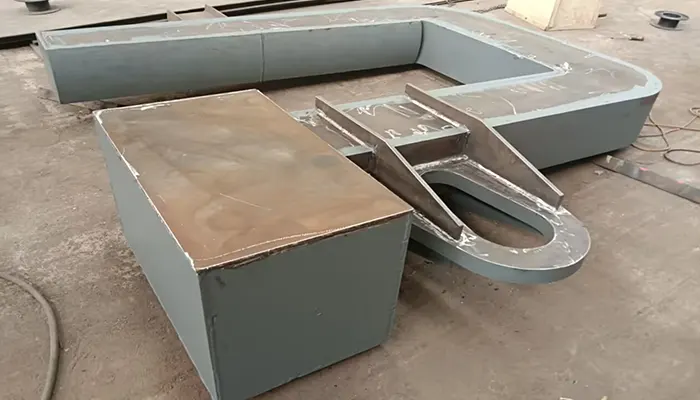
25 ton crane c hook under construction
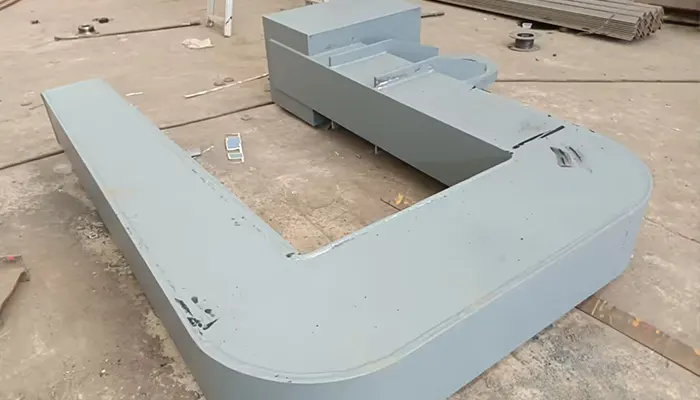
25 ton steel mill crane c hook under construction
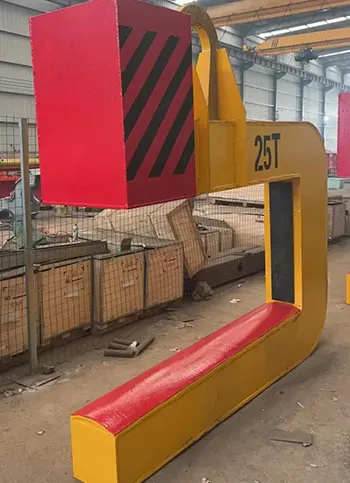
25 ton steel coil handling c hook
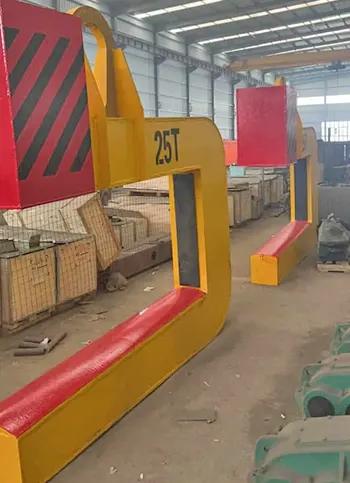
25 ton overhead crane c hook for steel mill

C hooks for delivery by containers
Manufacturing Standards and Certifications
To guarantee safety and reliability, the C hook adheres to several industry standards and certifications, including:
ISO 9001: Ensuring quality management throughout the production process
CE Certification: Compliance with European safety standards
ASME B30.20: Meeting the American Society of Mechanical Engineers' standards for below-the-hook lifting devices
Manufacturing Process
Step-by-Step Production Process
Design and Engineering: Initial design is created using CAD software, ensuring precise dimensions and load calculations. Structural analysis is conducted to validate the design against expected loads and stresses.
- Material Selection and Cutting: High-quality steel is selected based on the design specifications. Steel plates are cut to the required shapes using CNC machines for precision.
- Forming and Welding: The cut pieces are formed into the desired C shape using hydraulic presses. Pieces are welded together by certified welders to ensure strong, seamless joints.
- Machining: Machining processes are carried out to achieve exact dimensions and smooth finishes. Holes and slots are drilled as per the design requirements.
- Surface Treatment: The C hook undergoes surface treatment, including sandblasting and painting, to enhance corrosion resistance and aesthetic appeal.
- Assembly: Any additional components, such as lifting points or handles, are assembled and attached. The hook is inspected to ensure all parts are correctly fitted and functioning.
Quality Control Measures
- Inspection: Each C hook is inspected at multiple stages of production to ensure adherence to design specifications and quality standards. Non-destructive testing methods, such as ultrasonic testing, are used to detect any internal flaws in the welds and materials.
- Load Testing: Finished hooks are subjected to load tests, where they are tested at 1.25 times their rated capacity to ensure they can handle the specified loads safely.
Safety Standards Adhered to During Production
- Welding Standards: All welding processes comply with the American Welding Society (AWS) standards to ensure strong and reliable welds.
- Material Standards: Steel materials conform to ASTM (American Society for Testing and Materials) standards, ensuring high quality and consistency.
- Manufacturing Environment: The production facility follows strict safety protocols, including regular equipment maintenance and worker safety training, to minimize the risk of accidents and ensure a safe working environment.
By adhering to these rigorous production processes and quality control measures, the 25-ton C hook is manufactured to provide exceptional performance and reliability in handling steel coils.
Delivery of 25 Ton C Hooks for Japan, 2 Units
Transportation by Containers
To ensure the safe and efficient delivery of the 25-ton C hooks to Japan, we opted for containerized shipping. This method provides several advantages:
- Protection: Containers offer robust protection against environmental factors such as rain, humidity, and saltwater exposure during sea transport.
- Security: Containers can be securely locked, reducing the risk of theft or tampering during transit.
- Efficiency: Using standardized containers simplifies the loading, unloading, and handling processes, ensuring the hooks are handled with care throughout the journey.

25 ton c hoook, overhead crane attachment delivery
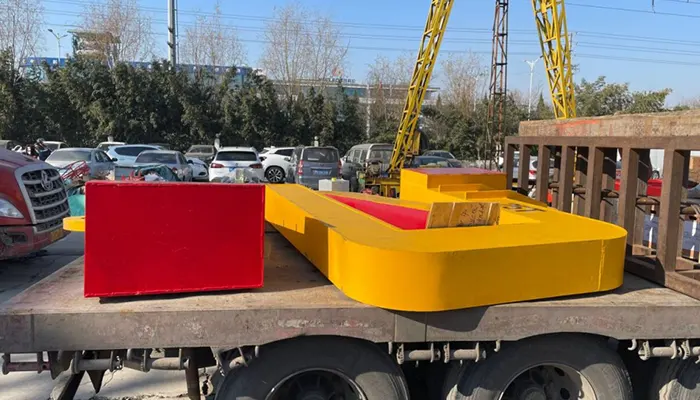
Steel coil handling for sale
Packaging and Handling to Ensure Safety During Transit
Proper packaging and handling are crucial to prevent damage to the C hooks during transit. Our approach included:
- Custom Crates: Each C hook was placed in a custom-built wooden crate designed to support its weight and dimensions. These crates were reinforced to withstand the stresses of transportation.
- Padding and Securing: Inside the crates, the hooks were padded with high-density foam and other cushioning materials to absorb shocks and vibrations. Straps and braces were used to secure the hooks in place, preventing any movement.
- Moisture Protection: Given the potential exposure to moisture during sea transit, each hook was wrapped in a moisture-resistant material, and desiccants were placed inside the crates to absorb any residual humidity.
- Labeling: The crates were clearly labeled with handling instructions, including weight warnings and proper orientation guidelines, to ensure careful handling by logistics personnel.

25 ton steel coil production in workshop

25 ton c hook for delivery by containers
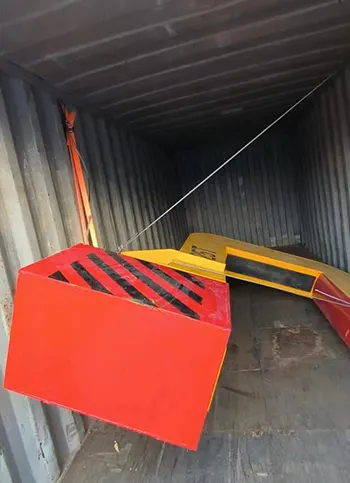
Fastening of c hook in container for delivery
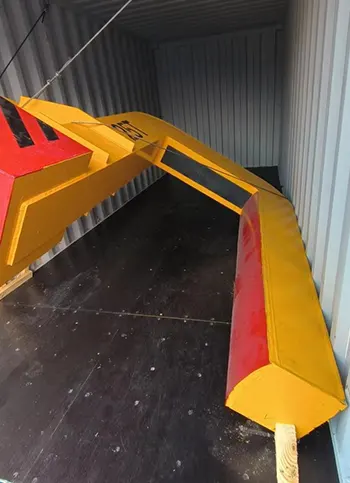
25 ton c hook device
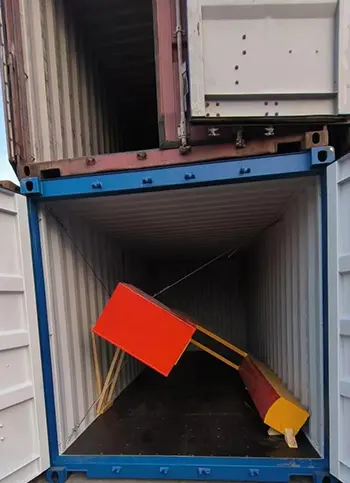
25 ton crane part, c hook for steel coil handling

Steel coil handling c hook
Regulatory Compliances for International Shipping
Shipping large industrial equipment like C hooks internationally involves navigating a complex web of regulations and compliance requirements. Key aspects of our regulatory compliance efforts included:
- Customs Documentation: We prepared all necessary customs documentation, including commercial invoices, packing lists, and certificates of origin, to facilitate smooth customs clearance.
- Export and Import Licenses: Ensuring we had the appropriate export licenses from the country of origin and import licenses for Japan was crucial. We worked closely with customs brokers to secure these licenses in advance.
- Standards Compliance: As the C hooks were designed and manufactured to meet Japanese Industrial Standards (JIS), we included relevant certification documents to prove compliance. This helped expedite the inspection and approval processes in Japan.
- Insurance: Comprehensive shipping insurance was arranged to cover any potential risks during transit, including damage, loss, or theft. This provided an additional layer of security for our valuable shipment.
- Environmental and Safety Regulations: We ensured that the packaging materials used were compliant with international environmental regulations, such as the ISPM 15 standard for wood packaging. This standard prevents the spread of pests and ensures the safety of the wooden crates used for the C hooks.
By meticulously planning the logistics and ensuring compliance with all regulatory requirements, we aimed to deliver the 25-ton C hooks to Japan in perfect condition and on schedule. This comprehensive approach to logistics and handling underscores our commitment to quality and customer satisfaction.
Documentation
Required Documentation for Customs Clearance
To ensure a smooth customs clearance process, the following documentation was prepared and submitted:
- Commercial Invoice: Detailed invoice listing the contents, value, and terms of the sale.
- Packing List: Comprehensive list of all items in the shipment, including dimensions and weights of each crate.
- Bill of Lading: Official document issued by the shipping company detailing the shipment and its destination.
- Certificate of Origin: Document certifying the country of manufacture of the C hooks, required for verifying tariff classification.
- Product Certification: Certifications proving that the C hooks meet Japanese Industrial Standards (JIS) and other relevant safety standards.
- Insurance Certificate: Proof of shipping insurance coverage to safeguard against potential risks during transit.
- Import Licenses: Necessary permits and licenses for importing the goods into Japan, as required by Japanese authorities.
Handling Import Duties and Taxes in Japan
To manage import duties and taxes effectively, we coordinated with customs brokers and local experts to ensure compliance with Japanese regulations. Key steps included:
- Duty Calculation: Calculating the applicable import duties based on the tariff classification of the C hooks and their declared value.
- Tax Payment: Arranging for the payment of import duties and value-added tax (VAT) upon entry into Japan. This involved liaising with our financial department to ensure funds were available and transferred promptly.
- Customs Brokerage: Engaging a professional customs broker in Japan to handle the clearance process, ensuring all paperwork was correctly filed and any issues were promptly addressed.
- Record Keeping: Maintaining accurate records of all import documentation and transactions for future reference and compliance audits.
By preparing detailed documentation and proactively managing the import process, we ensured a seamless and efficient delivery of the 25-ton C hooks to our client in Japan. --
Application in Steel Coil Handling
How C Hooks are Used
Detailed Description of How C Hooks are Used in Steel Coil Handling
C hooks play a crucial role in the handling of steel coils, providing a safe and efficient method for lifting, moving, and positioning these heavy and often unwieldy materials. Here's how C hooks are typically used in steel coil handling:
- Insertion into Coil Bore: The C hook is designed to easily fit into the central bore of a steel coil. The operator positions the hook so that its vertical arm slides into the coil's hollow center. The open part of the "C" allows for straightforward insertion and removal, reducing the time and effort needed to secure the coil.
- Lifting: Once the hook is securely in place, the overhead crane or lifting device hoists the hook, and consequently, the steel coil. The balance and structural integrity of the C hook ensure that the coil remains stable during the lifting process, minimizing the risk of slipping or dropping.
- Transportation: The coil, now suspended by the C hook, can be safely transported across the facility. This includes moving the coil from storage areas to processing lines or loading it onto transport vehicles. The smooth, controlled movement facilitated by the C hook helps prevent damage to the coil and ensures worker safety.
- Positioning and Placement: Upon reaching the destination, the operator carefully lowers the coil into the desired position, whether it's onto a conveyor belt, into a storage rack, or directly onto processing machinery. The C hook's design allows for precise placement, which is critical in manufacturing processes where exact positioning is necessary.
Release and Removal: After placing the coil, the hook is easily withdrawn by reversing the insertion process. The open "C" shape ensures that the hook can be quickly removed, ready to handle the next coil.
Types of Industries That Use C Hooks
C hooks are indispensable in a variety of industries where steel coils are a fundamental part of operations. Some of the key industries that rely on C hooks include:
- Steel Manufacturing: In steel mills and manufacturing plants, C hooks are used to handle raw steel coils during production, storage, and distribution. They facilitate the movement of coils between different stages of the manufacturing process, from rolling mills to finishing lines.
- Automotive Industry: Automotive manufacturers use steel coils for producing various car parts, such as body panels and frames. C hooks are employed to transport coils from storage areas to stamping and forming machines.
- Construction: Construction companies use steel coils for making structural components, roofing materials, and other building supplies. C hooks help in moving these coils efficiently within fabrication shops and onto construction sites.
- Metal Fabrication: Metal fabrication shops utilize steel coils to produce a wide range of products, including pipes, beams, and custom metal components. C hooks enable the safe handling of coils throughout the cutting, shaping, and welding processes.
- Shipping and Logistics: In ports and logistics centers, steel coils are frequently handled for import and export purposes. C hooks are essential for loading and unloading coils from ships, trucks, and railcars, ensuring quick and safe transfers.
- Appliance Manufacturing: Manufacturers of household appliances use steel coils to create outer casings, structural supports, and internal components. C hooks aid in transporting these coils to various assembly lines within the manufacturing plant.
By providing a secure and efficient method for handling steel coils, C hooks enhance operational efficiency, reduce the risk of damage, and improve safety across these industries. Their versatility and reliability make them a critical tool in any setting where steel coils are an integral part of the production or handling process.
Installation and Operation
Step-by-Step Guide on Installing the C Hook
Preparation:
- Inspect the C Hook: Before installation, thoroughly inspect the C hook for any signs of damage, wear, or defects. Check the structural integrity, welds, and coating to ensure it is safe to use.
- Review Load Capacity: Confirm that the C hook's load capacity matches the weight of the steel coils you intend to handle.
- Safety Check: Personal Protective Equipment (PPE): Ensure all personnel involved in the installation and operation are wearing appropriate PPE, including hard hats, gloves, safety glasses, and steel-toed boots.
- Area Clearance: Clear the area of any obstructions and ensure it is free of unauthorized personnel.
- Attachment to Crane: Positioning the Crane: Move the overhead crane to the installation area and lower the hook to a manageable height.
- Secure the C Hook: Attach the C hook to the crane's lifting mechanism (such as a chain or cable) using a secure shackle or hook. Ensure that the attachment point on the crane can handle the C hook's load capacity.
- Testing the Connection: Initial Lift: Conduct a trial lift by raising the C hook slightly off the ground to check the stability of the connection. Ensure the hook is securely attached and there are no signs of slippage or imbalance.
- Inspection: Perform a final visual inspection to confirm that all connections are secure and the C hook is properly aligned.
Best Practices for Safe and Efficient Operation
Load Positioning:
- Centering the Hook: Ensure the C hook is properly centered within the coil's bore before lifting. An off-center lift can cause the coil to swing or slip.
- Smooth Lifting: Use the crane controls to lift the coil smoothly and gradually. Avoid sudden movements that could destabilize the load.
- Monitoring Load: Load Indicators: Utilize any load indicators or sensors on the C hook to monitor the weight being lifted and ensure it does not exceed the rated capacity.
- Visual Inspection: Continuously monitor the load and the C hook during operation for any signs of stress or deformation.
- Maintaining Balance: Avoid Swinging: Minimize horizontal movements while the coil is suspended to prevent it from swinging. If movement is necessary, do so slowly and cautiously.
- Controlled Descent: When lowering the coil, do so in a controlled manner to ensure it is placed accurately and safely.
- Communication: Clear Signals: Establish clear hand signals or communication protocols between the crane operator and ground personnel to ensure coordinated movements.
- Regular Updates: Maintain constant communication during the lifting and moving process to promptly address any issues that arise.
- Routine Maintenance: Regular Inspections: Conduct regular inspections of the C hook to check for wear and tear, especially focusing on welds, load-bearing points, and the coating.
- Lubrication: Apply lubrication to any moving parts of the C hook as recommended by the manufacturer to ensure smooth operation.
- Safety Protocols: Emergency Procedures: Have clear emergency procedures in place in case of equipment failure or accidents. Ensure all personnel are trained to respond effectively.
- Load Limits: Never exceed the rated load capacity of the C hook. Always adhere to the manufacturer's guidelines and recommendations for safe operation.
By following these installation and operation guidelines, you can ensure the safe, efficient, and effective use of C hooks for handling steel coils. Proper installation and adherence to best practices not only enhance operational efficiency but also significantly reduce the risk of accidents and equipment damage.
Maintenance
Routine Maintenance Procedures
- Visual Inspection: Daily Checks: Before each use, perform a quick visual inspection to check for obvious signs of wear, damage, or deformation. Pay close attention to the hook opening, shackle points, and any welded joints.
- Monthly Inspection: Conduct a more thorough inspection monthly. This should include checking the integrity of the entire structure, including any bolts, nuts, and additional components.
- Cleaning: Regular Cleaning: Keep the C hook clean by removing any dirt, dust, or grease that can accumulate during operation. Use a dry cloth for general cleaning and a degreasing agent for more stubborn grime.
- Post-Use Cleaning: After heavy usage or exposure to harsh environments, clean the hook to prevent corrosion and other damage.
- Lubrication: Lubricate Moving Parts: Apply lubrication to any moving parts, such as swivel points or load-bearing hinges, according to the manufacturer's recommendations. Use a high-quality lubricant suitable for heavy-duty industrial equipment.
- Frequency: Perform lubrication monthly or more frequently if the hook is used in harsh or high-frequency applications.
- Corrosion Protection: Inspect Coating: Regularly check the hook's coating for any signs of wear or damage. Reapply anti-corrosion paint or treatment as needed to ensure the hook remains protected from rust and corrosion.
- Environmental Considerations: If operating in a coastal or highly humid environment, consider applying additional protective coatings or using desiccant packs in storage areas.
- Load Testing: Periodic Load Testing: Schedule periodic load tests to ensure the hook can still handle its rated capacity. Conduct these tests under controlled conditions, following the manufacturer's guidelines.
- Documentation: Keep detailed records of all load tests, including dates, results, and any corrective actions taken.
Troubleshooting Common Issues
Wear and Tear:
- Signs: Cracks, dents, or thinning of the hook material, especially around high-stress areas like the hook opening and load points.
- Actions: Immediately remove the hook from service if any significant wear is detected. Consult the manufacturer for repair or replacement recommendations.
Corrosion:
- Signs: Rust spots, flaking paint, or pitting on the hook's surface.
- Actions: Clean and treat the affected areas with a rust remover, then reapply an anti-corrosion coating. For severe corrosion, replace the affected parts or the entire hook.
Mechanical Malfunctions:
- Signs: Difficulty in moving parts, unusual noises during operation, or resistance in swivel points.
- Actions: Lubricate all moving parts and check for any obstructions. If the problem persists, disassemble the affected components for a more thorough inspection and repair.
Loose or Damaged Fasteners:
- Signs: Loose bolts, nuts, or any signs of wear on fasteners.
- Actions: Tighten any loose fasteners to the specified torque settings. Replace any damaged or worn fasteners immediately.
Alignment Issues:
- Signs: The hook does not sit correctly within the coil bore or appears misaligned during lifting.
- Actions: Check the hook's structure for any deformations or bends. Realign as necessary, or replace the hook if structural integrity is compromised.
Load Indicator Malfunctions:
- Signs: Inaccurate or no readings from load indicators.
- Actions: Inspect the load indicator sensors and connections for any damage or disconnection. Calibrate the indicators as per the manufacturer's instructions or replace faulty components.
By adhering to these routine maintenance procedures and promptly addressing common issues, you can extend the lifespan of your C hooks and ensure they continue to operate safely and efficiently. Regular maintenance not only enhances performance but also plays a crucial role in preventing accidents and costly downtime.
Features and Advantages of Steel Coil C Hooks
Key Design Features of C Hooks
Robust Construction:
- High-Strength Steel: C hooks are typically made from high-grade steel, providing the necessary strength to handle heavy loads, often exceeding 25 tons.
- Welded Joints: The hooks feature expertly welded joints that enhance structural integrity and durability, ensuring they can withstand repeated use in demanding environments.
Balanced Design:
- Ergonomic Shape: The "C" shape is specifically designed to fit securely around the central bore of steel coils, providing a stable lifting point that minimizes the risk of slipping or imbalance.
- Weight Distribution: The design ensures even weight distribution across the hook, reducing stress on individual components and extending the lifespan of the equipment.
Safety Features:
- Load Indicators: Many modern C hooks come equipped with load indicators that provide real-time data on the weight being lifted, helping operators stay within safe operating limits.
- Enhanced Grip Surfaces: The inclusion of textured or rubberized grip surfaces on contact points helps to secure the coil during lifting and movement, reducing the risk of slippage.
Protective Coatings:
- Anti-Corrosion Coating: A protective layer of anti-corrosion paint or treatment is applied to the hook, guarding against rust and wear, especially in harsh or humid environments.
- Heat Treatment: Some C hooks undergo heat treatment processes to improve their toughness and resistance to impact and wear.
Customizable Dimensions:
- Adjustable Sizes: C hooks can be customized in terms of hook opening, overall length, and width to accommodate different coil sizes and specifications.
- Additional Attachments: Options for additional attachments or modifications, such as extra lifting eyes or handles, to suit specific operational needs.
Innovations and Technological Advancements
- Advanced Materials: Composite Materials: In some cases, advanced composite materials are being used to create lighter, yet equally strong, C hooks. These materials can reduce overall equipment weight and improve maneuverability.
- High-Tensile Alloys: The use of high-tensile steel alloys increases the hook's strength-to-weight ratio, allowing for more efficient lifting without compromising safety.
Integrated Monitoring Systems:
- Smart Sensors: Integration of smart sensors within the C hook provides real-time monitoring of stress, load, and structural integrity. These sensors can alert operators to potential issues before they become critical.
- Wireless Connectivity: Some C hooks now feature wireless connectivity, enabling remote monitoring and data collection, which helps in maintaining accurate records of usage and wear.
Enhanced Ergonomics:
- Optimized Designs: Ergonomically optimized designs reduce operator fatigue and improve handling efficiency. This includes easier attachment points and more comfortable handling features.
- Automatic Adjustments: Innovations in design include automatic adjusting mechanisms that adapt the hook to different coil sizes without manual intervention, speeding up the handling process.
Safety Enhancements:
- Automatic Load Balancing: Some C hooks are equipped with automatic load balancing systems that adjust the center of gravity dynamically, ensuring a stable lift even with uneven loads.
- Emergency Release Mechanisms: Advanced hooks feature emergency release mechanisms that allow for quick detachment of the load in case of an emergency, enhancing workplace safety.
- Environmentally Friendly Coatings:: Eco-Friendly Treatments: Development of environmentally friendly anti-corrosion treatments and coatings that reduce environmental impact while providing superior protection against rust and wear.
By incorporating these key design features and leveraging technological advancements, modern steel coil C hooks offer enhanced performance, safety, and efficiency in material handling operations. These innovations not only improve operational effectiveness but also contribute to a safer and more sustainable industrial environment.
Advantages of C Hooks
Steel coil C hooks offer several distinct advantages over alternative handling methods, making them a preferred choice in various industries.
Increased Efficiency and Safety:
- Streamlined Handling: C hooks provide a quick and efficient method for lifting, moving, and positioning steel coils, reducing downtime and increasing productivity.
- Enhanced Safety: The secure grip and balanced design of C hooks minimize the risk of accidents such as slippage or coil displacement, ensuring a safer working environment for operators.
Cost-Effectiveness Compared to Other Handling Methods:
- Reduced Labor Costs: C hooks require minimal manual labor for operation, leading to cost savings in terms of labor expenses and time.
- Optimized Workflow: The efficiency of C hooks in handling steel coils results in faster turnaround times and increased throughput, maximizing overall operational efficiency.
Durability and Longevity:
- Robust Construction: C hooks are built to withstand heavy-duty industrial use, with high-grade steel construction and expert welding ensuring long-term durability.
- Minimal Maintenance: With proper care and maintenance, C hooks can provide years of reliable service, minimizing downtime and replacement costs.
Versatility and Adaptability:
- Customizable Design: C hooks can be customized to accommodate different coil sizes, weights, and specifications, offering versatility in handling various types of steel coils.
- Multi-Use Applications: C hooks are not limited to handling steel coils; they can also be used for lifting and transporting other cylindrical or semi-cylindrical objects, increasing their utility and value.
Environmental Considerations:
- Reduced Material Waste: C hooks facilitate precise handling and positioning of steel coils, minimizing the risk of damage or material waste during transport and storage.
- Sustainable Practices: The longevity and durability of C hooks contribute to sustainability by reducing the need for frequent replacements and minimizing resource consumption.
- Compliance with Safety Standards: Meeting Industry Regulations: C hooks are designed and manufactured to comply with industry safety standards and regulations, ensuring adherence to best practices and minimizing liability risks for businesses.
In summary, the advantages of steel coil C hooks encompass increased efficiency, enhanced safety, cost-effectiveness, durability, versatility, and environmental sustainability. These benefits make C hooks an indispensable tool in steel coil handling operations, enabling businesses to optimize their processes while ensuring the safety of their workforce and reducing operational costs in the long run.
Limitations of C Hooks for Steel Coil Handling
Despite their numerous advantages, steel coil C hooks have certain limitations that must be considered to ensure safe and effective operation.
Load Capacity Constraints
Maximum Load Capacities and Risks of Exceeding Them
- Defined Load Limits: C hooks are engineered to handle specific maximum load capacities, typically ranging from a few tons to over 25 tons, depending on the hook's design and construction. Exceeding these load limits can lead to catastrophic failure, resulting in damage to equipment, property, and potentially causing serious injury or loss of life.
- Structural Integrity: When subjected to loads beyond their rated capacity, C hooks may experience structural deformation, weld failures, or material fatigue, compromising their integrity and safety. Overloading can cause the hook to bend, twist, or break, posing significant hazards to both personnel and surrounding equipment.
Impact on Hook Performance and Safety
- Reduced Stability: Overloading a C hook can destabilize the load, increasing the risk of slippage, swinging, or tipping during lifting and movement. This instability not only endangers personnel but also risks damaging the steel coils and surrounding infrastructure.
- Loss of Control: Excessive loads can strain the crane or lifting mechanism, impairing its ability to control the hook's movement accurately. Loss of control over the load height, position, or trajectory poses a serious safety hazard, potentially causing collisions, entanglements, or structural damage.
- Compromised Equipment Lifespan: Continuous overloading accelerates wear and tear on the C hook, shortening its operational lifespan and necessitating more frequent maintenance and replacement. Increased stress on the hook's components can lead to premature failure, resulting in unexpected downtime and repair costs.
Mitigation Strategies
- Adherence to Load Limits: Strictly adhere to the manufacturer's specified load capacities and operating guidelines for the C hook. Conduct regular training sessions for personnel involved in lifting operations to ensure awareness of load limits and associated risks.
- Routine Inspections: Implement a comprehensive inspection program to assess the condition of C hooks regularly. Look for signs of wear, damage, or deformation that may compromise the hook's load-bearing capacity.
- Real-Time Monitoring: Utilize load indicators or monitoring systems integrated into the C hook to provide real-time feedback on the load being lifted. Train operators to recognize and respond promptly to any indications of overloading or unsafe conditions.
- Operational Controls: Implement administrative controls, such as work procedures and load planning, to prevent overloading of C hooks. Encourage open communication between crane operators, riggers, and supervisors to ensure safe lifting practices are followed consistently.
- Continuous Improvement: Regularly review and update safety protocols and risk assessments to address emerging hazards and lessons learned from past incidents. Encourage a culture of safety awareness and proactive hazard identification among all personnel involved in steel coil handling operations.
By acknowledging and addressing the limitations associated with load capacity constraints, businesses can mitigate risks and ensure the safe and efficient use of steel coil C hooks in their operations. Compliance with load limits is essential to safeguarding personnel, equipment, and assets, while maintaining productivity and minimizing downtime.
Operational Limitations
Specific Conditions Where C Hooks May Not Be Suitable
- Extreme Coil Dimensions: C hooks are designed to handle a wide range of coil sizes and configurations. However, exceptionally large or irregularly shaped coils may present challenges for C hook usage. In such cases, alternative lifting methods, such as coil grabs or spreader bars, may be more appropriate to ensure secure handling and stability.
- Restricted Access: Limited space or restricted access within the work area can impede the effective use of C hooks. Tight corners, narrow aisles, or overhead obstacles may hinder maneuverability and increase the risk of collisions or damage to equipment and structures.
- High-Speed Operations: C hooks are best suited for controlled and deliberate lifting and movement of steel coils. High-speed operations, such as rapid acceleration or deceleration, may exceed the hook's design limitations and compromise safety. In environments where fast-paced handling is required, specialized lifting equipment with higher response times and dynamic capabilities may be more suitable.
Potential Wear and Tear in Certain Environments
- Corrosive Environments: Exposure to corrosive substances, such as acids, salts, or chemicals, can accelerate the degradation of C hooks, leading to premature wear and corrosion. Regular maintenance, including cleaning and protective coating application, is essential to mitigate the effects of corrosion and prolong the hook's lifespan in such environments.
- High-Temperature Operations: Extended exposure to high temperatures, such as those found in steel mills or foundries, can affect the material properties of C hooks and compromise their structural integrity. Heat-resistant coatings or materials may be necessary to protect the hook from thermal degradation and maintain its performance in these environments.
- Abrasive Surfaces: Handling steel coils with abrasive surfaces or sharp edges can cause accelerated wear and abrasion on the hook's contact points. Regular inspection and replacement of worn components, such as grip surfaces or protective coatings, are essential to prevent damage and ensure safe operation.
Mitigation Strategies
- Environmental Assessments: Conduct thorough assessments of the operating environment to identify potential hazards and limitations associated with C hook usage. Implement appropriate controls and safeguards to mitigate risks, such as installing protective barriers or implementing restricted access zones.
- Material Selection: Select C hooks constructed from materials with superior corrosion resistance and durability, especially for use in harsh environments. Consider specialized coatings or treatments tailored to the specific operating conditions to enhance longevity and performance.
- Regular Maintenance and Inspection: Establish a comprehensive maintenance schedule to inspect and service C hooks regularly, paying particular attention to areas prone to wear and tear. Promptly address any signs of damage or deterioration to prevent further degradation and ensure safe operation.
- Operator Training: Provide comprehensive training to operators on the limitations and operational considerations associated with C hook usage. Emphasize the importance of adhering to manufacturer guidelines and best practices to minimize risks and maintain safety standards.
By recognizing and addressing operational limitations, businesses can optimize the effectiveness and safety of steel coil C hooks in their operations. Proactive risk management and mitigation strategies are essential to ensure the continued reliability and performance of lifting equipment in diverse operating environments.
Alternative Solutions
Other Handling Equipment Options and Their Use Cases For Coil Handling Crane Systems for Your Reference:
Coil Grabs:
Coil grabs are suitable for lifting steel coils with irregular shapes or configurations that may not be compatible with C hooks. They offer a more flexible grip and can handle coils with varying diameters and widths. Coil grabs utilize clamping mechanisms or adjustable arms to securely grip the coil's outer circumference. They are often used in applications where precise positioning or maneuverability is required.
Spreader Bars:
Spreader bars are ideal for lifting multiple coils simultaneously or for distributing the load evenly across a larger surface area. They are commonly used in operations where efficiency and throughput are prioritized. Spreader bars consist of a horizontal beam with multiple attachment points for connecting to lifting slings or cables. They help prevent deformation or damage to coils by distributing the load evenly.
Magnetic Lifters:
Magnetic lifters are suitable for handling steel coils with smooth, flat surfaces where traditional lifting methods may not be feasible. They offer quick attachment and release, making them ideal for high-speed operations. Magnetic lifters utilize powerful electromagnets to create a secure grip on the steel coil's surface. They are often used in environments where access is restricted or where manual handling is impractical.
Forklift Attachments:
Forklift attachments, such as coil rams or clamps, can be used to lift and transport steel coils using existing forklift equipment. They offer versatility and convenience for handling coils in warehouse or storage settings. Forklift attachments are mounted onto the forks of a standard forklift and use hydraulic or mechanical mechanisms to secure the coil during lifting and movement. They are particularly useful for indoor applications with limited space.
Comparative Analysis
- Load Capacity: C Hooks: C hooks typically have high load capacities, ranging from a few tons to over 25 tons, making them suitable for heavy-duty lifting applications.
- Alternative Solutions: Coil grabs, spreader bars, and magnetic lifters may have varying load capacities depending on their design and configuration. While some models can handle heavy loads, others may be limited to lighter-duty operations.
- Flexibility: C Hooks: C hooks offer a secure and stable grip on steel coils but may have limitations in handling irregularly shaped or oversized coils.
- Alternative Solutions: Coil grabs, spreader bars, and magnetic lifters provide greater flexibility in handling a wider range of coil sizes and shapes. They can accommodate variations in coil diameter, width, and weight more effectively.
- Speed and Efficiency: C Hooks: C hooks offer quick and efficient handling of steel coils, especially in applications where precise positioning and controlled movements are required.
- Alternative Solutions: Coil grabs, spreader bars, and magnetic lifters may offer faster attachment and release times, making them suitable for high-speed operations or environments with repetitive lifting tasks.
- Cost Considerations: C Hooks: C hooks are typically a one-time investment with minimal ongoing maintenance costs, making them cost-effective in the long run.
- Alternative Solutions: The cost of alternative handling equipment may vary depending on factors such as load capacity, features, and complexity. While some options may have higher upfront costs, they may offer advantages in terms of versatility and performance.
In summary, while C hooks remain a popular choice for lifting and handling steel coils, alternative solutions such as coil grabs, spreader bars, magnetic lifters, and forklift attachments offer distinct advantages in specific use cases. Businesses should carefully evaluate their lifting requirements, operational constraints, and budgetary considerations to determine the most suitable equipment for their needs.
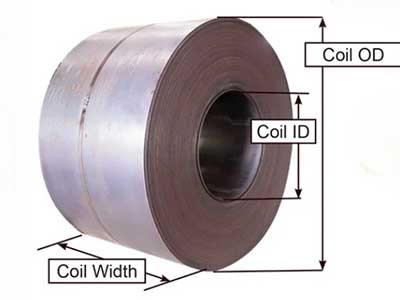
How to Get Your Customized Steel Coil C Hooks
When it comes to steel coil C hooks, customization allows businesses to tailor their lifting equipment to specific requirements, ensuring optimal performance and safety. Here are the customization options available:
Range of Customization Options Available
- Size and Dimensions: C hooks can be customized to accommodate different coil sizes, diameters, and widths. This ensures a precise fit and secure grip, minimizing the risk of slippage or imbalance during lifting. Clients can specify the overall length, width, and depth of the C hook to suit their specific application and handling needs.
- Load Capacity: Custom load capacities are available to meet the unique lifting requirements of different industries and applications. Clients can request load capacities ranging from a few tons to over 25 tons, depending on the weight of the steel coils being handled.
- Design Features: Clients can choose from a variety of design features to enhance the functionality and performance of their C hooks. Options include different hook shapes, grip surfaces, swivel mechanisms, and attachment points, allowing for greater flexibility and customization.
- Material Selection: The choice of materials can be tailored to suit specific operating environments and conditions. Clients can opt for different grades of steel, coatings, and treatments to enhance durability, corrosion resistance, and longevity.
Process for Requesting Custom Features
Initial Consultation: Clients begin by discussing their lifting requirements and specifications with the manufacturer or supplier. This includes providing details such as coil dimensions, weight, handling environment, and any special considerations.
- Engineering Assessment: The manufacturer conducts an engineering assessment to evaluate the feasibility of the customization request and determine the most suitable design and materials. This may involve simulations, calculations, and prototype development to ensure the customized C hook meets performance and safety standards.
- Design Approval: Once the design concept is finalized, clients review and approve the proposed customization options, including size, load capacity, and design features. Any necessary adjustments or modifications are made based on client feedback before proceeding to production.
- Production and Testing: The customized C hooks are manufactured according to the approved design specifications, using high-quality materials and precision engineering techniques. Rigorous testing and quality control procedures are conducted to verify the performance, safety, and durability of the customized C hooks.
- Delivery and Installation: Upon completion, the customized C hooks are delivered to the client's facility and installed by trained professionals. Clients receive comprehensive training and support to ensure the safe and effective use of their customized lifting equipment.
By offering a wide range of customization options and a systematic process for requesting custom features, manufacturers can provide clients with tailored solutions that meet their specific lifting requirements and operational challenges. Customized steel coil C hooks enhance efficiency, safety, and productivity in steel coil handling operations, ultimately contributing to the success and growth of businesses across various industries.
Consultation and Design
Customizing steel coil C hooks involves a collaborative process between clients and experienced engineers and designers. Here's how the consultation and design phase typically unfold:
Initial Consultation Process
- Needs Assessment: Clients initiate the process by contacting the manufacturer or supplier to discuss their lifting requirements and challenges. During this initial consultation, clients provide details such as the type and size of steel coils being handled, operational environment, safety considerations, and any specific features or functionalities desired.
- Requirement Gathering: Engineers and sales representatives work closely with clients to gather comprehensive information about their lifting application. This includes understanding factors such as load capacity, coil dimensions, weight distribution, frequency of use, space constraints, and any regulatory or industry compliance requirements.
- Site Evaluation (if applicable): In some cases, engineers may conduct on-site evaluations to assess the physical layout, infrastructure, and operational conditions where the C hooks will be used. Site visits help identify potential challenges, safety hazards, and opportunities for optimization to ensure the customized solution aligns with the client's needs and objectives.
Collaborating with Engineers and Designers to Meet Specific Needs
- Design Conceptualization: Based on the information gathered during the initial consultation, engineers and designers collaborate to conceptualize the customized C hook design. This involves translating client requirements into technical specifications, considering factors such as material selection, structural design, load-bearing capacity, ergonomics, and safety features.
- Iterative Design Process: Engineers iteratively refine the design concept through discussions, feedback sessions, and feasibility assessments with clients. CAD (Computer-Aided Design) software and modeling techniques are employed to visualize the proposed design, allowing clients to provide input and make adjustments as needed.
- Engineering Analysis: Engineers conduct structural analysis, simulations, and stress tests to evaluate the proposed design's performance under different loading conditions. Finite Element Analysis (FEA) and other advanced engineering tools help identify potential weaknesses, optimize structural integrity, and ensure compliance with safety standards and regulations.
- Client Review and Approval: Once the design concept is finalized, clients review and approve the proposed solution, including technical drawings, 3D models, and specifications. Clients have the opportunity to provide feedback, request modifications, or suggest additional features before moving forward to the production phase.
By fostering open communication, collaboration, and expertise sharing between clients, engineers, and designers, the consultation and design phase of customizing steel coil C hooks ensures that the final product meets the client's unique lifting requirements while adhering to the highest standards of quality, safety, and performance. This collaborative approach lays the foundation for successful implementation and long-term satisfaction with the customized lifting solution.
Ordering Process : Step-by-Step Guide on Placing an Order
- Consultation and Requirement Analysis: Contact the manufacturer or supplier to initiate the ordering process. Discuss your lifting requirements, including coil dimensions, load capacity, customization preferences, and any specific needs or constraints.
- Customization Proposal: Based on the consultation, the manufacturer provides a detailed proposal outlining the customized solution, including design specifications, features, and pricing. Review the proposal carefully to ensure it aligns with your requirements and expectations.
- Design Approval: Upon agreement with the proposed solution, approve the finalized design and specifications. Provide any necessary feedback or revisions before proceeding to production.
- Order Confirmation: Confirm the order with the manufacturer, specifying quantities, delivery details, and any additional requirements. Ensure clarity on payment terms, production timelines, and delivery expectations.
- Payment: Make the initial payment as per the agreed-upon terms to initiate production. Payment options may include wire transfer, credit card, or other mutually agreed-upon methods.
- Production and Manufacturing: The manufacturer begins the production process according to the approved design and specifications. Experienced engineers and skilled craftsmen ensure precision manufacturing and adherence to quality standards.
- Quality Assurance and Testing: Each customized C hook undergoes rigorous quality assurance and testing procedures to verify performance, safety, and compliance with specifications. This may include load testing, material inspections, and functional checks to ensure reliability and durability.
- Final Inspection and Approval: Once production is complete, a final inspection is conducted to verify that the customized C hooks meet all requirements and standards. Client approval is sought before proceeding to delivery.
- Delivery and Installation: The customized C hooks are securely packaged and prepared for shipment according to agreed-upon delivery terms. Upon arrival, the C hooks are installed at the client's facility by trained professionals to ensure proper setup and functionality.
- Training and Support: Clients receive comprehensive training on the safe and effective use of the customized C hooks. Ongoing support is provided to address any questions, concerns, or maintenance needs.
- Production and Delivery Timeline for Custom Orders:Production timelines vary depending on factors such as customization complexity, quantity, and current workload. A typical production timeline for custom orders ranges from several weeks to a few months, from design approval to delivery. The manufacturer provides an estimated timeline at the time of order confirmation, with regular updates throughout the production process to keep clients informed of progress. Delivery timelines are coordinated with the client to ensure timely arrival based on shipping logistics and installation requirements.
Conclusion
In conclusion, the customization of steel coil C hooks offers businesses a tailored solution to meet their specific lifting requirements, enhancing efficiency, safety, and productivity in steel coil handling operations. Throughout this guide, we've explored the process of customizing C hooks, from consultation and design to the ordering process and delivery. Here's a recap of key points:
- Consultation and Design: A collaborative approach involving engineers, designers, and clients ensures that customized C hooks are designed to meet unique lifting needs and operational challenges.
- Ordering Process: Clients follow a step-by-step process, from initial consultation and design approval to payment and delivery, to acquire customized C hooks tailored to their specifications.
- Payment Options and Terms: Payment terms and options are outlined in the initial proposal, providing flexibility and clarity for clients throughout the ordering process.
- Production and Delivery Timeline: The production timeline for custom orders varies based on complexity and quantity, with regular updates provided to clients to ensure transparency and accountability.
Choosing the right C hook for steel coil handling is paramount to the success and safety of lifting operations. Customization allows businesses to optimize their lifting equipment to suit their unique needs, ensuring efficient and secure handling of steel coils. By partnering with experienced manufacturers and suppliers, businesses can access expertise, innovation, and support to achieve their lifting goals.
Main Projects
Related Products

Supplied three grab bucket crane kits to Indonesia, enhancing garbage handling efficiency with high load capacity and reliable performance.
Free consultation to Confirm Parameters & Specifications and Get
Latest Crane Price & Crane Rate.
- Types of overhead cranes : _______?
- Optional: Overhead travelling crane, goliath gantry crane,Slewing jib crane, Single girder or double girder crane,small portable crane or kbk crane, etc.
- Capacity of overhead crane: _______?
- Optional: 0.25ton, 0.5 ton, 1 ton, 2 ton, 3ton, 5 ton, 10 ton,15ton, 20ton, 25 ton, 30ton,35ton, up to 550ton, etc.
- Crane span & lifting height : _______?
- Crane travelling length : _____?
- Control of overhead crane:_______?
- Optional: pendant/ remote/cabin control
- Voltage supply of overhead crane:_____?
- Eg,: 380V50/60HZ,3Phase or others,etc.
- Application/usage of crane:_______?
- Eg,: Steel mill, ,injection mold, cement,stone, concrete,granite, general manufacturing, etc.
Just leave a message via the contact form and our hoist and crane engineer will contact you with in 24working hours.
Get In Touch











